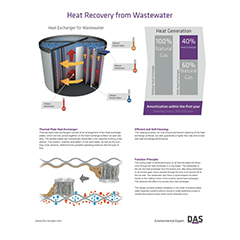Heat exchanger keeps wastewater systems working reliably and enables heat recovery from the wastewater flow
Dresden (Germany), April 29, 2014. Many companies need hot process water in their production processes. An innovative system from Dresden (Germany) based DAS Environmental Expert GmbH now enables heat transfer from wastewater to process water. This helps to optimise the temperatures in the water flows, which significantly increases efficiency with regard to both energy usage and wastewater treatment.
Packaging specialist trusts in process water solutions from DAS EE GmbH
Schumacher Packaging GmbH gained experience with this type of heat exchanger in its plant in Schwarzenberg. The owner-run, medium-sized company specialises in tailored packaging solutions using corrugated and solid board. The company employs 2,200 workers and generates an annual turnover of around €400 million. The company was founded in 1948 and has a head office in Ebersdorf near Coburg (Germany). Schumacher Packaging GmbH produces cardboard in Schwarzenberg in the Ore Mountains. This production process involves processing waste paper. “A large amount of water is needed for this process”, states Bernd Dzedzig, responsible project manager at DAS Environmental Expert GmbH. “We get this water from the river Grosse Mittweida. In winter, the water is relatively cold when it arrives with temperatures of around five degrees Celsius. It is pre-cleaned and previously had to be heated using steam or other external heat sources.”
The challenge: Biological wastewater treatment despite of high process temperatures
Schumacher Packaging GmbH has now increased the capacity of the paper machine. This also resulted in an increase in the process temperature to up to 55 degrees Celsius, which is much too high for the biological wastewater treatment to follow. The microorganisms die if the water is too hot. The result: “The sewage treatment plant would no longer work at these temperatures”, explains Dzedzig. To prevent damage to the river, an official upper temperature limit of 30 degrees Celsius is also in place for discharging wastewater.
The solution: The heat exchanger from the German environmental experts
Schumacher Packaging GmbH therefore began searching for a smart concept for cooling the wastewater to ensure that the biological wastewater treatment system could continue to work reliably. DAS Environmental Expert GmbH impressed the company with its system concept: The heat exchanger uses the water heated during the process to heat the cold fresh water. And there is another additional benefit: Schumacher Packaging GmbH can even reduce its energy consumption by using the system. Using the heat exchanger can save the plant 40% of the natural gas previously required. Thus, the investment pays for itself in just one year.
The principle: effective thermal plates with an effective cleaning system
The heat exchanger from DAS Environmental Expert GmbH uses double-wall plates (“thermal plates”), which are kept clean at all times with a simple cleaning system (see info graphic). The cooling water is distributed evenly over all thermal plates and flows through the heat exchanger once in a ring shape. The wastewater is fed into the heat exchanger from the bottom and flows upwards through the tank to be drained off at the top side. So the cold river water flows on the inside of the thermal plates and the hot wastewater flows on the outside.
The heat exchanger is made of stainless steel. Metal surfaces soil relatively easily through contact with the wastewater, explains Dzedzig: “A bio film forms within a short time, which grows quickly if the heat exchangers are not cleaned. This results in a reduction in the exchange performance.” It is therefore usually necessary to dismantle the systems regularly and clean them manually. The Dresden based environmental experts have also come up with a clever technical solution for this problem: Soiling is reduced to a minimum with a continuously rotating brush system and the heat exchange is optimised. The rotating brushes not only ensure permanent cleaning of the heat exchange surfaces, but also guarantee a higher flow rate and increased heat exchange performance. The wastewater also flows in spiral-shaped circulation thanks to the rotating motion of the brushes. This achieves the effect of a counter-flow heat exchanger. This design principle enables installation in the outlet of existing wastewater treatment systems without using additional pressure booster pumps. No elaborate measurement and control technology is required.



























